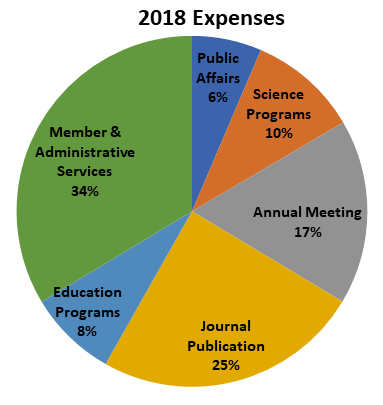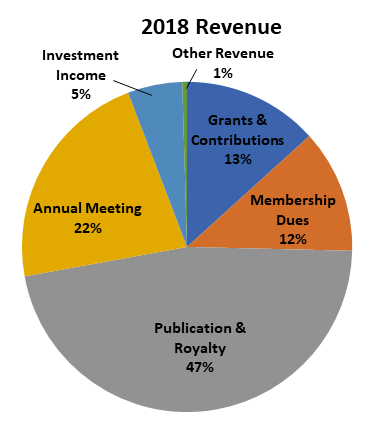Managing the ESA budget
Blogpost from ESA President Laura Huenneke
June 4, 2019
 ESA strives to provide excellent programs that benefit its members. A great deal of thought and planning goes into the ESA budget to ensure that programs are successful and are meeting our members’ expectations. An important role of the ESA Governing Board is to oversee finances. ESA’s members pay annual dues, and those attending our meetings pay registration fees. What other resources does the Society have to call upon? At its meeting in May, the Governing Board reviewed last year’s audited financial statements and adopted the proposed budget for 2019-2020. While some may see the ESA budget shrouded in fog, the actual budget development process and how the funds are spent is clear-cut and transparent. Still, it’s worth reviewing the ESA budget for members in detail. I use the 2018 financial results and activities below to provide a budget snapshot for members.
ESA strives to provide excellent programs that benefit its members. A great deal of thought and planning goes into the ESA budget to ensure that programs are successful and are meeting our members’ expectations. An important role of the ESA Governing Board is to oversee finances. ESA’s members pay annual dues, and those attending our meetings pay registration fees. What other resources does the Society have to call upon? At its meeting in May, the Governing Board reviewed last year’s audited financial statements and adopted the proposed budget for 2019-2020. While some may see the ESA budget shrouded in fog, the actual budget development process and how the funds are spent is clear-cut and transparent. Still, it’s worth reviewing the ESA budget for members in detail. I use the 2018 financial results and activities below to provide a budget snapshot for members.
As a mid-sized scientific society, ESA has a budget of moderate size and complexity. In the 2018 fiscal year, $5.8 million in revenue was available to fund the activities of the Society. What do we use our funds to accomplish? Where do those funds come from? How predictable are the sources and uses of our funds? How does the Governing Board exercise its fiduciary responsibility to safeguard the Society’s ability to achieve its purposes?
Expenditures: insight into priorities
M ost budgets and standard financial documents present revenues or income at the top of the page and expenditures below, but I’m going to start with expenditures since that is most directly related to purpose. What do we do with our financial resources each year? The simplest answer is that we use the funds to support and provide services to our members and to the discipline of ecology. In the formal budget, the largest line item (as in most research projects or educational or non-profit institutions) is salary and benefits, as is true for most research projects, educational institutions, or other organizations. Other substantive line items include the expense of running the annual meeting, financial support for the editors of our journals, and expenditures from the grants we use to fund our science and education programs.
ost budgets and standard financial documents present revenues or income at the top of the page and expenditures below, but I’m going to start with expenditures since that is most directly related to purpose. What do we do with our financial resources each year? The simplest answer is that we use the funds to support and provide services to our members and to the discipline of ecology. In the formal budget, the largest line item (as in most research projects or educational or non-profit institutions) is salary and benefits, as is true for most research projects, educational institutions, or other organizations. Other substantive line items include the expense of running the annual meeting, financial support for the editors of our journals, and expenditures from the grants we use to fund our science and education programs.
Spending by program activity categories is shown below and reflect the organization’s priorities. Grouping expenses by function allocates the personnel costs, staff travel, and other operational expenses among major purposes. As befits a scientific society, publication of the journals and management of the Annual Meeting constitute some of the largest budget commitments. Science and education programs (supported by core funding as well as by grants) are also a major activity. Direct membership services and the communications and programs of the Public Affairs Office are smaller but highly valuable investments (as reflected by feedback from our members). Of course, as in any formal organization, there is considerable administration expense, supporting the professional staff and office in DC, as well as Governing Board meetings and other governance expense.
Revenues: where do our resources come from?
 Sources of revenue from fiscal year 2018 are shown below. Our single largest source of revenue by far—almost 50% of the total—is the amount we receive as income and royalties on our journals through the publishing agreement with Wiley. This revenue replaces funds that ESA received directly as subscriptions (from both members and institutions), an income stream that became increasingly uncertain and volatile, as members dropped their print subscriptions and libraries struggled to sustain acquisitions budgets.
Sources of revenue from fiscal year 2018 are shown below. Our single largest source of revenue by far—almost 50% of the total—is the amount we receive as income and royalties on our journals through the publishing agreement with Wiley. This revenue replaces funds that ESA received directly as subscriptions (from both members and institutions), an income stream that became increasingly uncertain and volatile, as members dropped their print subscriptions and libraries struggled to sustain acquisitions budgets.
Our Annual Meeting in August contributes the next largest amount of gross revenue, 22%. This revenue is offset by what we spend in putting on the meeting—everything from venue rental to coffee breaks, the printing of the program to the subsidies for childcare. In most years, the conference net does constitute an important contribution to ESA’s total budget, assisting in the provision of member services and the operations of DC office and staff. In 2007 the Governing Board advised staff that the meeting should net a minimum of $80,000 (from total revenue of approximately $1M). This amount was increased to a minimum net of $125,000 in 2019. The meeting has consistently operated with this margin successfully, though low attendance in Fort Lauderdale was a challenge. While low rates for venue rentals and other expenses can help provide a positive outcome, the single greatest correlation to net revenue is total meeting attendance; thus, selecting sites expected to have high registration numbers has been a primary goal. (However, events can rapidly change the outlook for sites selected several years previously.)
Direct payment of dues from members continues to be an important revenue component, accounting for 12% of total income. These funds go directly to providing membership benefits including policy news, professional development, and committee activities. Membership varies more from year-to-year than used to be the case, and membership totals have declined since a high of roughly 10,200 members in 2007. Several recent analyses have confirmed that membership numbers are correlated with registration at the Annual Meeting, suggesting that many individuals do not pay dues unless they anticipate registering for the meeting (at the discounted members’ rate); this enlarges the importance of Annual Meeting site selection for the Society’s finances.
One final important source of income is grant funding (and the indirect cost recovery associated with sponsored projects). The Society relies on external funding to operate many of the education, diversity, and science support programs offered to members.
Managing our budget despite uncertainty
Crafting and managing annual budgets for organizations as large and complex as ESA is challenging, especially given the many unknowns each year. Variations in Annual Meeting attendance and net revenue, fluctuations in membership numbers, and past vulnerability to declines in journal subscriptions all made it difficult to make precise estimates of the income available for staff and programs in a given year. Our partnership with Wiley (launched in 2016) has stabilized publication income, but the heavy reliance on this large source of funds is part of why we are paying close attention to possible future changes in the business model of scientific publishing. The importance of the Annual Meeting’s net is a primary factor in the many deliberations and recommendations of the Future Meetings Committee and each year’s meeting Program Committee.
In the non-profit sector, it is well-established best practice to have a full year’s operating budget held in reserve, so that the organization could ride out a difficult year without immediately cutting member services, laying off staff that support our journals and programs or shutting the DC office. The Governing Board and ESA started building this reserve years ago, after a disastrous period when we had been losing money year-after-year and were just starting the discipline of having balanced budgets. Now we are nearing the goal of a full year’s equivalent of funds in reserve. At that point, the Board could start to think about spending some of the interest yielded by those reserves (while keeping the one-year reserve intact).
All members can be grateful that ESA has been so responsible with its funds for these past 20 years. The Society’s Chief Financial Officer, Liz Biggs, has produced and managed a balanced or net positive budget every year since she joined us in 1997. Both Liz and a succession of dedicated Vice Presidents for Finance have overseen the allocation of resources to Society priorities and the slow, but the steady building over 20 years of the one-year emergency reserve fund while also navigating major changes and fluctuations in revenue sources. Building the prudent reserve is akin to the tortoise and the hare story that extolls the value of working over decades to reach the finish line. And for 20-plus years, ESA’s annual audit has been “clean” —no accounting problems and no serious questions about managing or accounting for funds. Quite an enviable record for an organization of this complexity and size!
Sometimes people equate “nonprofit” with the concept of operating on a shoestring or purposefully maintaining a very small budget. But “nonprofit” shouldn’t mean risking deficits or being irresponsible with resources. The organization exists to fulfill a purpose and managing resources wisely while remaining solvent (being able to meet payroll and keep the lights on) is a necessary foundation to fulfilling the purpose.
Over my years with ESA, I’ve been grateful to see increased professionalism and attention to sound fiscal practices. We’re also committed to transparency in our financial management. Audited financial statements are posted on the ESA website, and the Annual Report has a summary of the financial statements. I’m happy to field questions or discuss our budget principles with any member—you are welcome to email me directly (laura.huenneke@nullnau.edu) or come talk it over with us in Louisville!
Laura F. Huenneke
President